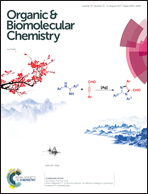Stereoselective synthesis of conformationally restricted KOR agonists based on the 2,5-diazabicyclo[2.2.2]octane scaffold†
Abstract
It has been postulated that the KOR affinity depends on the dihedral angle of the ethylenediamine pharmacophore. Herein, 2,5-diazabicyclooctanes bearing a pyrrolidino moiety in the 7-position were envisaged to study KOR agonists with a conformationally rigid ethylenediamine pharmacophore and thus a defined N(pyrrolidine)–C7–C1–N2 dihedral angle. The first approach with an intramolecular addition at the chiral sulfinylimines 9 failed to give bicyclic products. The key step in the second approach was a Dieckmann analogous cyclization providing mixed methyl silyl ketals 11a–e as key intermediates. The highest KOR affinity was found for the 2,5-dibenzyl substituted derivatives (S,R,S)-16a (Ki = 31 nM) and (R,S,R)-16a (Ki = 74 nM) with the pyrrolidine ring oriented towards N-5. The high KOR affinity of (S,R,S)-16a is unexpected, since the KOR pharmacophoric ethylenediamine system adopts a dihedral angle of about 160°, which is quite different from the angle of the energetically most favored conformer of the flexible and potent KOR agonist 2. (S,R,S)-16a represents a KOR agonist with moderate selectivity over MOR (8-fold) and DOR (5-fold), but high selectivity over both σ receptor subtypes. In the [35S]GTPγS assay (S,R,S)-16a reacted as a full KOR agonist with an EC50 value of 240 nM.
![Graphical abstract: Stereoselective synthesis of conformationally restricted KOR agonists based on the 2,5-diazabicyclo[2.2.2]octane scaffold](/en/Image/Get?imageInfo.ImageType=GA&imageInfo.ImageIdentifier.ManuscriptID=C7OB01530E&imageInfo.ImageIdentifier.Year=2017)


 Please wait while we load your content...
Please wait while we load your content...